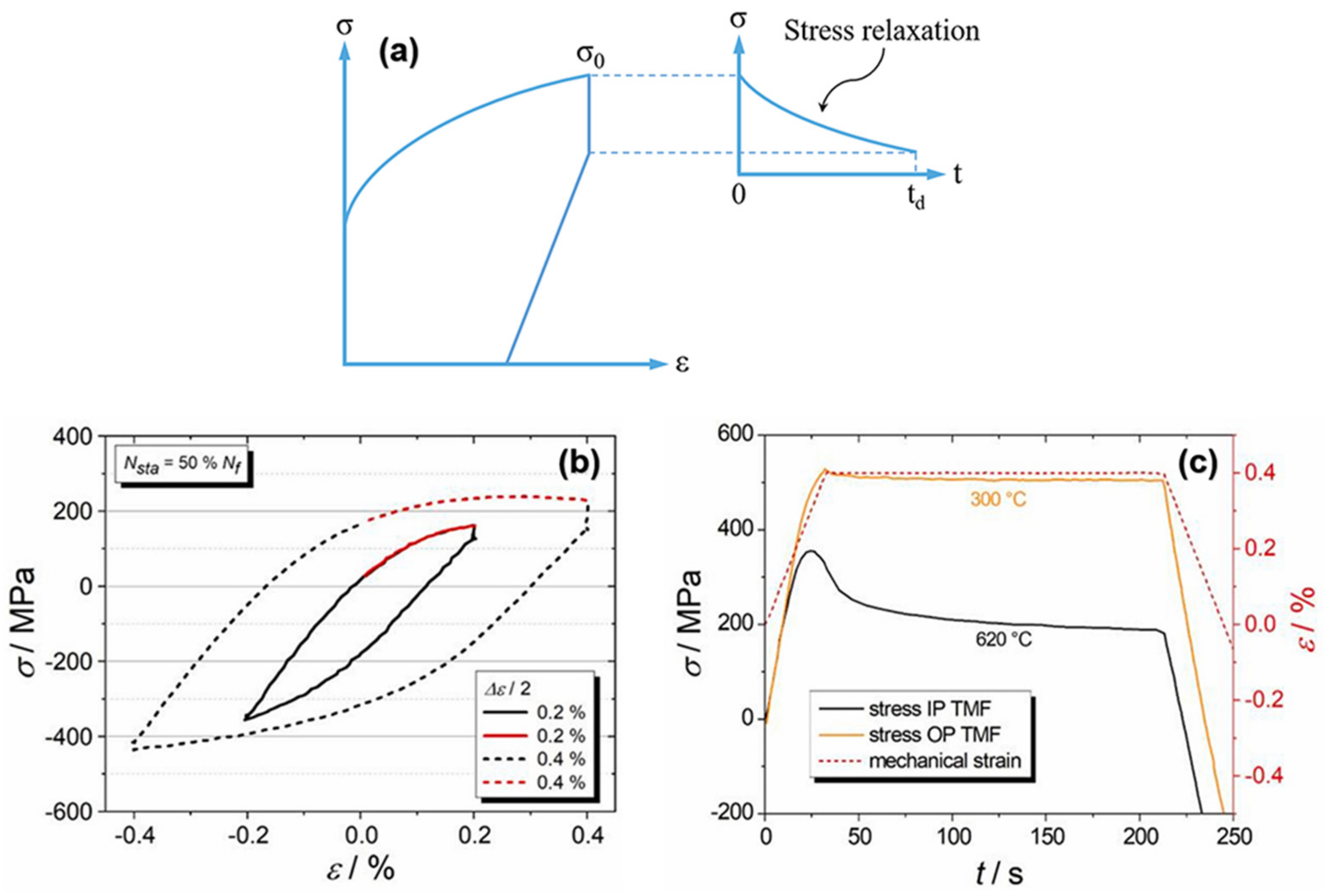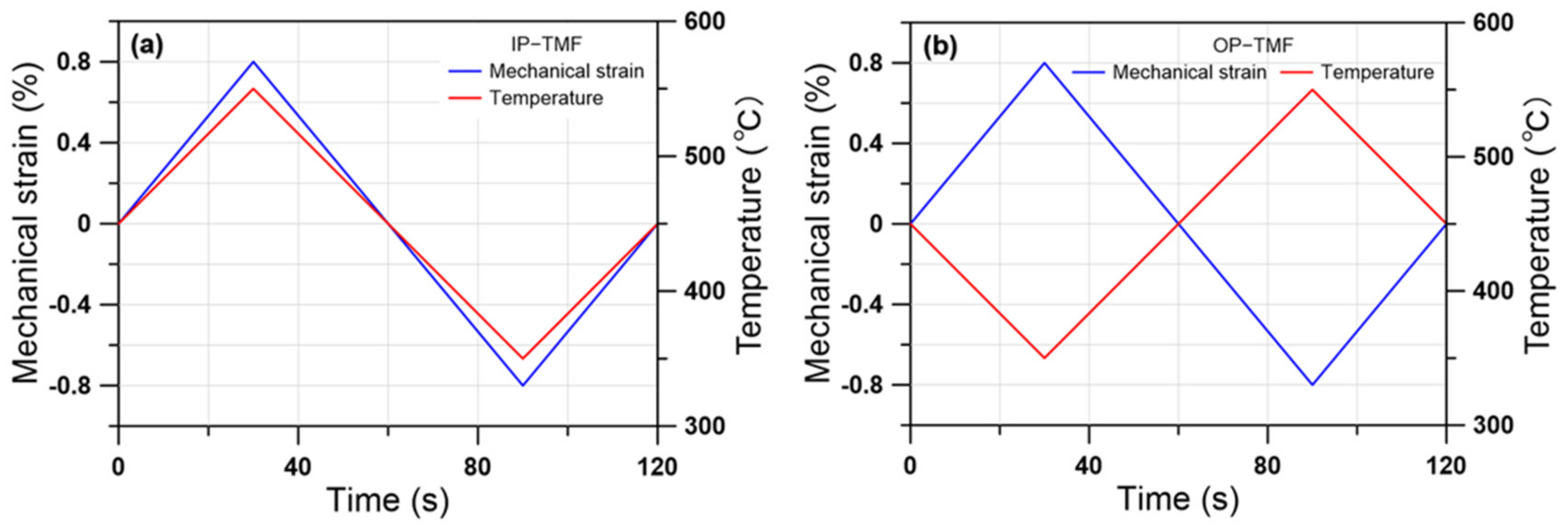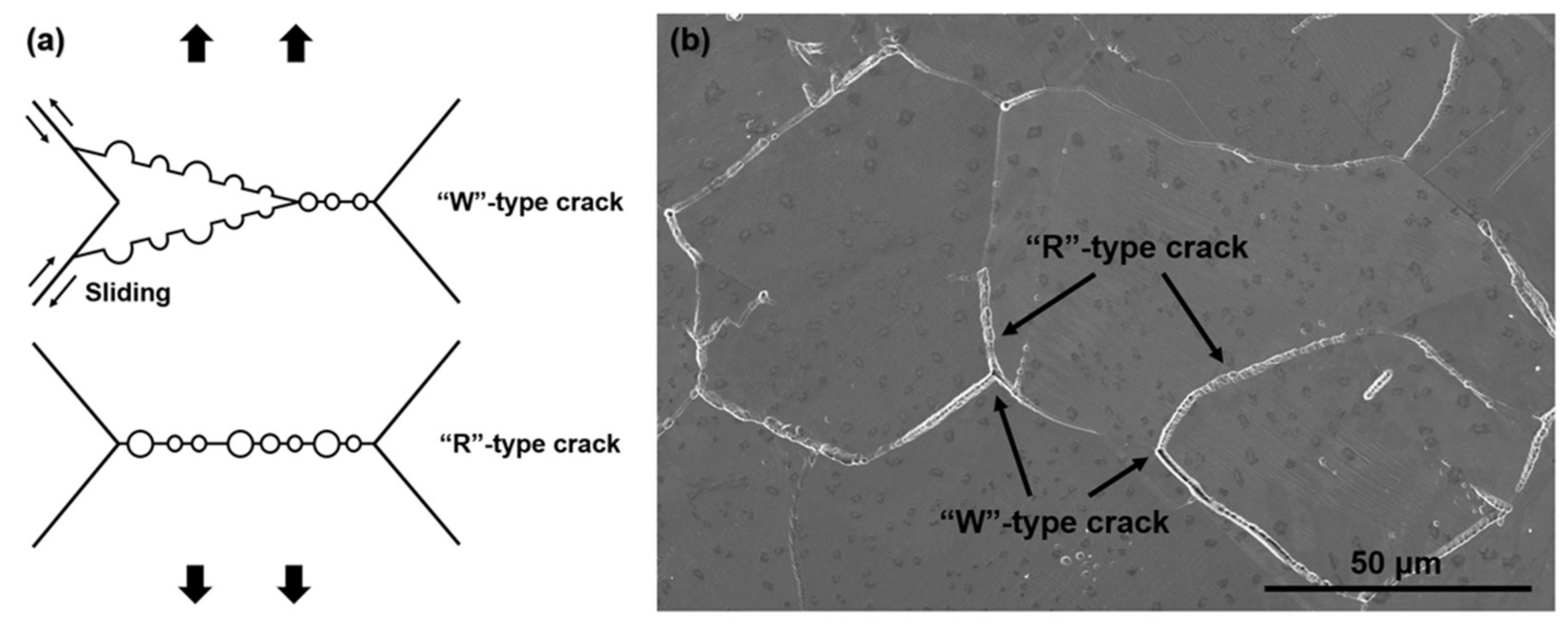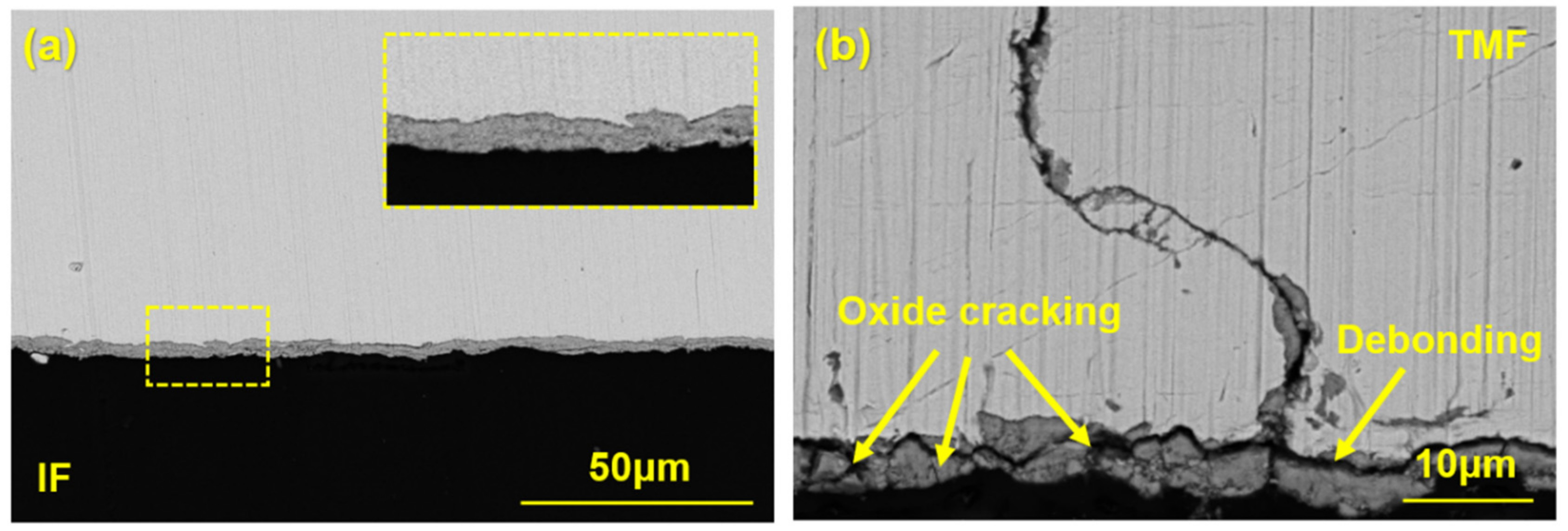Review of Creep-Thermomechanical Fatigue Behavior of Austenitic Stainless Steel
Abstract
:1. Introduction
2. Methods
3. Stress Response Behavior under CTMF Loading Conditions
3.1. Cyclic Stress Response
3.2. Stress Relaxation Behavior
4. Damage Mechanisms under CTMF Loading Conditions
4.1. Thermomechanical Fatigue
4.2. Creep
4.3. Oxidation
4.4. Dynamic Strain Aging
5. Fatigue Life Behavior under CTMF Loading Conditions
5.1. Effect of Strain Dwell Type on Life Behavior
5.2. Effect of Dwell Time on Life Behavior
5.3. Effect of Temperature-Strain Phase Angle on Life Behavior
6. Conclusions and Outlook
Author Contributions
Funding
Institutional Review Board Statement
Informed Consent Statement
Data Availability Statement
Conflicts of Interest
References
- Ganesan, V.; Laha, K.; Mathew, M.D. Influence of nitrogen content on the evolution of creep damage in 316LN stainless steel. Procedia Eng. 2014, 86, 58–65. [Google Scholar] [CrossRef] [Green Version]
- Reddy, G.V.P.; Parameswaran, P.; Sandhya, R.; Laha, K. Creep-fatigue interaction behavior of 316LN austenitic stainless steel with varying nitrogen content. Mater. Des. 2015, 88, 972–982. [Google Scholar] [CrossRef]
- Nagesha, A.; Kannan, R.; Parameswaran, P.; Sandhya, R.; Rao, K.B.S.; Singh, V. A comparative study of isothermal and thermomechanical fatigue on type 316LN austenitic stainless steel. Mater. Sci. Eng. A 2010, 527, 5969–5975. [Google Scholar] [CrossRef]
- Ellison, E.G.; Al-Zamily, A. Fracture and life prediction under thermal-mechanical strain cycling. Fatigue Fract. Eng. Mater. Struct. 1994, 17, 53–67. [Google Scholar] [CrossRef]
- Bae, K.-H.; Kim, H.-H.; Lee, S.-B. Competing damage mechanisms in the thermo-mechanical fatigue of AISI 304L stainless steel. Mater. Sci. Eng. A 2011, 529, 417–424. [Google Scholar] [CrossRef]
- Fournier, B.; Sauzay, M.; Caes, C.; Noblecourt, M.; Mottot, M.; Bougault, A.; Rabeau, V.; Pineau, A. Creep-fatigue-oxidation interactions in a 9Cr-1Mo martensitic steel. Part I: Effect of tensile holding period on fatigue lifetime. Int. J. Fatigue 2008, 30, 649–662. [Google Scholar] [CrossRef]
- Guth, S.; Lang, K.-H. Influence of dwell times on microstructure, deformation and damage behavior of NiCr22Co12Mo9 under thermomechanical fatigue. Mater. Sci. Eng. A 2020, 794, 139970. [Google Scholar] [CrossRef]
- Guth, S.; Petras, R.; Skorik, V.; Krumi, R.; Man, J.; Lang, K.H.; Polak, J. Influence of dwell times on the thermomechanical fatigue behavior of a directionally solidified Ni-base superalloy. Int. J. Fatigue 2015, 80, 426–433. [Google Scholar] [CrossRef]
- Jurgens, M.; Sonntag, N.; Olbricht, J.; Fedelich, B.; Skrotzki, B. The effect of dwell time on the thermomechanical fatigue life performance of grade P92 steel at intermediate and low strain amplitudes. Mater. Sci. Eng. A 2021, 805, 140593. [Google Scholar] [CrossRef]
- Bartoak, M.; Horvath, J.; Bartosak, M.; Rohlova, M. Life assessment of a low-alloy martensitic steel under isothermal low-cycle fatigue-creep and thermo-mechanical fatigue-creep loading conditions. Int. J. Fatigue 2020, 145, 106092. [Google Scholar] [CrossRef]
- Zhang, X.; Tu, S.-T.; Xuan, F. Creep-fatigue endurance of 304 stainless steel. Theor. Appl. Fract. Mech. 2014, 71, 51–66. [Google Scholar] [CrossRef]
- Hales, R. A quantitative metallographic assessment of structural degradation of type 316 stainless steel during creep-fatigue. Fatigue Eng. Mater. Struct. 1980, 4, 339–356. [Google Scholar] [CrossRef]
- Zauter, R.; Christ, H.J.; Mughrabi, H. Mughrabi Some aspects of thermomechanical fatigue of AISI 304L stainless steel: Part I. creep-fatigue damage. Metall. Mater. Trans. A 1994, 25, 401–406. [Google Scholar] [CrossRef]
- Alsmadi, Z.Y.; Alomari, A.; Kumar, N. Effect of hold time on high temperature creep-fatigue behavior of Fe-25Ni-20Cr (wt.%) austenitic stainless steel (Alloy 709). Mater. Sci. Eng. A 2020, 771, 138591. [Google Scholar] [CrossRef]
- Srinivasan, V.S.; Nagesha, A.; Valsan, M.; Rao, K.B.S.; Mannan, S.L.; Sastry, D.H. Effect of hold-time on low cycle fatigue behavior of nitrogen bearing 316L stainless steel. Int. J. Press. Vessel. Pip. 1999, 76, 863–870. [Google Scholar] [CrossRef]
- Kim, D.W.; Chang, J.-H.; Ryu, W.-S. Evaluation of the creep-fatigue damage mechanism of type 316L and type 316LN stainless steel. Int. J. Press. Vessel. Pip. 2008, 85, 378–384. [Google Scholar] [CrossRef]
- Sarkar, A.; Okazaki, M.; Nagesha, A. Mechanisms of failure under low cycle fatigue, high cycle fatigue and creep interactions in combined cycling in a type 316LN stainless steel. Mater. Sci. Eng. A 2017, 683, 24–36. [Google Scholar] [CrossRef]
- Nagesha, A.; Valsan, M.; Kannan, R.; Rao, K.B.S.; Bauer, V.; Christ, H.-J.; Singh, V. Thermomechanical fatigue evaluation and life prediction of 316L(N) stainless steel. Int. J. Fatigue 2009, 31, 636–643. [Google Scholar] [CrossRef]
- Kumar, T.S.; Nagesha, A.; Kannan, R. Thermal cycling effects on the creep-fatigue interaction in type 316LN austenitic stainless steel weld joint. Int. J. Press. Vessel. Pip. 2019, 178, 104009. [Google Scholar] [CrossRef]
- Sarkar, A.; Dash, M.K.; Nagesha, A.; Dasgupta, A.R. EBSD based studies on various modes of cyclic deformation at 923K in a type 316LN stainless steel. Mater. Sci. Eng. A 2018, 723, 229–237. [Google Scholar] [CrossRef]
- Kuwabara, K.; Nitta, A. Thermal-mechanical low-cycle fatigue under creep-fatigue interaction on type 304 stainless steel. Fatigue Eng. Mater. Struct. 1979, 2, 293–304. [Google Scholar] [CrossRef]
- Fournier, B.; Sauzay, M.; Caes, C.; Noblecourt, M.; Pineau, A. Creep-fatigue interactions in a 9Cr-1Mo martensitic steel. Part I: Mechanical test results. Metall. Mater. Trans. A 2009, 40, 321–329. [Google Scholar] [CrossRef]
- Goswami, T.; Hanninen, H. Dwell effects on high temperature fatigue damage mechanisms Part II. Mater. Des. 2001, 22, 217–236. [Google Scholar] [CrossRef]
- Sauzay, M.; Mottot, M.; Allais, L.; Noblecourt, M.; Monnet, I. Creep-fatigue behavior of an AISI stainless steel at 550 °C. Nucl. Eng. 2004, 232, 219–236. [Google Scholar] [CrossRef]
- Wood, D.S.; Banks, P. The creep/fatigue behavior of type 316 steel under reverse bending conditions. Fatigue Fract. Eng. Mater. Struct. 1990, 13, 551–561. [Google Scholar] [CrossRef]
- Wang, J.; Li, N.; Anderoglu, O.; Zhang, X.; Misra, A.; Huang, J.Y.; Hirth, J.P. Detwinning mechanisms for growth twins in face-centered cubic metals. Acta Mater. 2010, 58, 2262–2270. [Google Scholar] [CrossRef]
- Dewa, R.T.; Park, J.H.; Kim, S.J.; Sang, L. High-temperature creep-fatigue behavior of alloy 617. Metals 2018, 8, 103. [Google Scholar] [CrossRef] [Green Version]
- Takahashi, Y.; Shibamoto, H.; Inoue, K. Study on creep-fatigue life prediction methods for low-carbon nitrogen-controlled 316 stainless steel (316FR). Nucl. Eng. Des. 2008, 238, 322–335. [Google Scholar] [CrossRef]
- Li, B.; Zheng, Y.; Shi, S.; Chen, X. Microcrack nucleation and early crack growth of a nuclear grade nitrogen alloyed austenitic stainless steel X2CrNiMo18.12 under thermomechanical fatigue loading. Int. J. Press. Vessel. Pip. 2019, 172, 188–198. [Google Scholar] [CrossRef]
- Holmstrom, S.; Pohja, R.; Nurmela, A.; Moilanen, P.; Auerkari, P. Creep and creep-fatigue behavior of 316 stainless steel. Procedia Eng. 2013, 55, 160–164. [Google Scholar] [CrossRef]
- Wu, H.; Yang, B.; Wang, S.; Zhang, M. Effect of oxidation behavior on the corrosion fatigue crack initiation and propagation of 316LN austenitic stainless steel in high temperature water. Mater. Sci. Eng. A 2015, 633, 176–183. [Google Scholar] [CrossRef]
- Li, B.; Zheng, Y.; Shi, S.; Zhang, Z.; Chen, X. Cyclic deformation and cracking behavior of 316LN stainless steel under thermomechanical and isothermal fatigue loadings. Mater. Sci. Eng. A 2020, 773, 138866. [Google Scholar] [CrossRef]
- Reddy, G.V.P.; Nagesha, A.; Kannan, R.; Sandhya, R.; Laha, K. Thermomechanical fatigue behavior of nitrogen enhanced 316LN stainless steel: Effect of cyclic strain. Int. J. Fatigue 2017, 103, 176–184. [Google Scholar] [CrossRef]
- Neu, R.W.; Sehitoglu, H. Thermomechanical fatigue, oxidation and creep: Part I. damage mechanisms. Metall. Trans. A 1989, 20, 1755–1767. [Google Scholar]
- Kim, D.W.; Kim, W.G.; Rye, W.-S. Role of dynamic strain aging on low cycle fatigue and crack propagation of type 316LN stainless steel. Int. J. Fatigue 2003, 25, 1203–1207. [Google Scholar] [CrossRef]
- Ganesan, V.; Mathew, M.D.; Parameswaran, P.; Laha, K. Effect of nitrogen on evolution of dislocation substructure in 316LN SS during creep. Procedia Eng. 2013, 55, 36–40. [Google Scholar] [CrossRef] [Green Version]
- Reddy, G.V.P.; Kannan, R.; Mariappan, K.; Sandhya, R.; Sankaran, S.; Rao, K.B.S. Effect of strain rate on low cycle fatigue of 316LN stainless steel with varying nitrogen content: Part-I cyclic deformation behavior. Int. J. Fatigue 2015, 81, 299–308. [Google Scholar] [CrossRef]
- Reddy, G.V.P.; Sandhya, R.; Rao, K.B.S.; Sankaran, S. Influence of nitrogen alloying on dynamic strain ageing regimes in low cycle fatigue of AISI 316LN stainless steel. Procedia Eng. 2010, 2, 2181–2188. [Google Scholar] [CrossRef] [Green Version]
- Shankar, P.; Shaikh, H.; Sivakumar, S. Effect of thermal aging on the room temperature tensile properties of AISI type 316LN stainless steel. J. Nucl. Mater. 1999, 264, 29–34. [Google Scholar] [CrossRef]
- Majumdar, S. Relationship of creep, creep-fatigue and cavitation damage in type 304 austenitic stainless steel. J. Eng. Mater. Technol. 1989, 111, 123–131. [Google Scholar] [CrossRef]
- Baik, S.; Raj, R. Mechanisms of creep-fatigue interaction. Metall. Trans. A 1982, 13, 1215–1221. [Google Scholar] [CrossRef]
- Min, B.K.; Raj, R. Hold-time effects in high temperature fatigue. Acta Metall. 1978, 26, 1007–1022. [Google Scholar] [CrossRef]
- Maciejewski, K.; Dahal, J.; Sun, Y. Creep-environment interactions in dwell-fatigue crack growth of nickel based superalloys. Metall. Mater. Trans. A 2014, 45, 2508–2521. [Google Scholar] [CrossRef]
- Rodriguez, P.; Rao, K.B.S. Nucleation and growth of cracks and cavities under creep-fatigue interaction. Prog. Mater. Sci. 1993, 37, 403–480. [Google Scholar] [CrossRef]
- Zhao, J.; Li, B.; Zheng, Y.; Mohammad, A.; Chen, X. Cyclic deformation behavior and failure mechanism of 316LN stainless steel under creep-fatigue loading at 550 °C. J. Mater. Eng. Perform. 2022, 4, 8314–8326. [Google Scholar] [CrossRef]
- Chen, J.; Nurrochman, A.; Hong, J.-D. Comparison of oxide layers formed on the low-cycle fatigue crack surfaces of Alloy 690 and 316 SS tested in a simulated PWR environment. Nucl. Eng. Technol. 2019, 51, 479–489. [Google Scholar] [CrossRef]
- Karabela, A.; Zhao, L.; Lin, B.; Tong, J.; Hardy, M.C. Oxygen diffusion and crack growth for a nickel-based superalloy under fatigue-oxidation conditions. Mater. Sci. Eng.A 2013, 567, 46–57. [Google Scholar] [CrossRef] [Green Version]
- Evans, H.E. Stress effects in high temperature oxidation of metals. Int. Mater. Rev. 1995, 40, 1–40. [Google Scholar] [CrossRef]
- Weiss, J.; Pineau, A. Fatigue and creep-fatigue damage of austenitic stainless steel under multiaxial loading. Metall. Trans. A 1993, 24, 2247–2261. [Google Scholar] [CrossRef]
- Li, B.; Zheng, Y.; Li, Q.; Liu, C.; Chen, X. Thermomechanical fatigue properties and microstructural damage of nitrogen alloyed 316LN stainless steel. Int. J. Fatigue 2020, 138, 105704. [Google Scholar] [CrossRef]
- Gao, J.; Tan, J.; Wu, X.; Xia, S. Effect of grain boundary engineering on corrosion fatigue behavior of 316LN stainless steel in borated and lithiated high-temperature water. Corros. Sci. 2019, 152, 190–201. [Google Scholar] [CrossRef]
- Nagesha, A.; Kannan, R.; Srinivasan, V.S. Dynamic strain aging and oxidation effects on the thermomechanical fatigue deformation of reduced activation ferritic-martensitic steel. Metall. Mater. Trans. A 2016, 47, 47–1127. [Google Scholar] [CrossRef]
- Zhao, J.; Li, B.; Chen, G.; Takamoto, I.; Chen, X. Effect of dwell time on the isothermal and thermomechanical fatigue behavior of 316LN stainless steel. Int. J. Fatigue 2022, 162, 106989. [Google Scholar] [CrossRef]
- Bartosák, M.; Horváth, J.; Spaniel, M. Multiaxial low-cycle thermal-mechanical fatigue of a low-alloy martensitic steel: Cyclic mechanical behavior, damage mechanisms and life prediction. Int. J. Fatigue 2021, 151, 106383. [Google Scholar] [CrossRef]
- Warner, H.; Calmunger, M.; Chai, G. Thermomechanical fatigue behavior of aged heat resistant austenitic alloys. Int. J. Fatigue 2019, 127, 509–521. [Google Scholar] [CrossRef]
- Chang, L.; Li, X.; Wen, J.; Zhou, B.; Zhou, C. Thermal-mechanical fatigue behavior and life prediction of P92 steel, including average temperature and dwell effects. J. Mater. Res. Technol. 2020, 9, 819–837. [Google Scholar] [CrossRef]
- Christ, H.-J. Effect of environment on thermomechanical fatigue life. Mater. Sci. Eng. A 2007, 468–470, 98–108. [Google Scholar] [CrossRef]
- Petrás, R.; Skorik, V.; Polak, J. Thermomechanical fatigue and damage mechanisms in Sanicro-25 steel. Mater. Sci. Eng. A 2016, 650, 52–62. [Google Scholar] [CrossRef]
- Petrás, R.; Polák, J. Damage mechansim in austenitic steel during high temperature cyclic loading with dwells. Int. J. Fatigue 2018, 113, 335–344. [Google Scholar] [CrossRef]
- Zhang, Z.; Tan, J.; Wu, X.; Han, E.; Ke, W. Synergistic effect of mechanical and environmental damages of 316LN stainless steel under different fatigue strain amplitudes in high-temperature pressurized water. Mater. Sci. Eng. A 2019, 743, 243–250. [Google Scholar] [CrossRef]
- Calmunger, M.; Chai, G.; Johansson, S. Creep and fatigue interaction behavior in Sanicro 25 heat resistant austenitic stainless steel. Trans. Indian Inst. Met. 2016, 69, 337–342. [Google Scholar] [CrossRef]
- Srinivasan, V.S.; Valsan, M.; Rao, K.; Mannan, S.L.; Raj, B. Low cycle fatigue and creep-fatigue interaction behavior of 316LN stainless steel and life prediction by artificial neural network approach. Int. J. Fatigue 2003, 25, 1327–1338. [Google Scholar] [CrossRef]
- Zhou, H.; Bai, F.; Yang, L.; Wei, H.; Chen, Y. Mechanism of dynamic strain aging in a niobium-stabilized austenitic stainless steel. Metall. Mater. Trans. A 2018, 49, 1202–1210. [Google Scholar] [CrossRef]
- Zhou, H.; He, Y.; Cui, M.; Cen, Y.; Jiang, J. Dependence of dynamic strain aging on strain amplitudes during the low-cycle fatigue of TP347H austenitic stainless steel at 550 °C. Int. J. Fatigue 2013, 56, 1–7. [Google Scholar] [CrossRef]
- Li, H.; Jing, H.; Xu, L.; Zhao, L.; Han, Y.; Tang, Z.; Xiao, B.; Zhang, Y. Life, dislocation evolution and fracture mechanism of a 41Fe-25.5Ni-23.5Cr alloy during low cycle fatigue at 700 °C. Int. J. Fatigue 2018, 119, 20–33. [Google Scholar] [CrossRef]
- Li, B.; Zheng, Y.; Zhao, J.; Shi, S.; Zhang, Z.; Chen, X. Cyclic deformation behavior and dynamic strain aging of 316LN stainless steel under low cycle fatigue loadings at 550 °C. Mater. Sci. Eng. A 2021, 818, 141411. [Google Scholar] [CrossRef]
- Sarkar, A.; Nagesha, A.; Parameswaran, P.; Murugesan, S.; Sandhya, R.; Laha, K. Insights into dynamic strain aging under cyclic creep with reference to strain burst: Some new observations and mechanisms. Part-1: Mechanistic aspects. Mater. Sci. Eng. A 2016, 660, 213–224. [Google Scholar] [CrossRef]
- Nagesha, A.; Kannan, R.; Sastry, G.V.S.; Sandhya, R.; Singh, V.; Rao, K.B.S.; Mathew, M.D. Isothermal and thermomechanical fatigue studies on a modified 9Cr-1Mo ferritic martensitic steel. Mater. Sci. Eng. A 2012, 554, 95–104. [Google Scholar] [CrossRef]
- Pham, M.S.; Holdsworth, S.R. Dynamic strain ageing of AISI 316L during cyclic loading at 300℃: Mechanism, evolution and its effects. Mater. Sci. Eng. A 2012, 556, 122–133. [Google Scholar] [CrossRef]
- Fournier, B.; Sauzay, M.; Caes, C.; Noblecourt, M.; Mottot, M. Bougault, A. Rabeau, V.; Pineau, A. Creep-fatigue-oxidation interactions in a 9Cr-1Mo martensitic steel. Part II: Effect of compressive holding period on fatigue lifetime. Int. J. Fatigue 2008, 30, 663–676. [Google Scholar] [CrossRef]
- Shankar, V.; Valsan, M.; Rao, K.B.S.; Kannan, R.; Mannan, S.L.; Pathak, S.D. Low cycle fatigue behavior and microstructural evolution of modified 9Cr-1Mo ferritic steel. Mater. Sci. Eng. A 2006, 437, 413–422. [Google Scholar] [CrossRef]
- Conway, J.B.; Stentz, R.H.; Berling, J.T. Fatigue, Tensile and Relaxation Behavior of Stainless Steel; Mar-Test: Cincinnati, OH, USA, 1975. [Google Scholar]
- Nam, S.W. Assessment of damage and life prediction of austenitic stainless steel under high temperature creep-fatigue interaction condition. Mater. Sci. Eng. A 2002, 322, 64–72. [Google Scholar] [CrossRef]
- Koterazawa, R.; Nosho, T. Creep-fatigue crack growth and fractography of a type 304 stainless steel at elevated temperature. Fatigue Fract. Eng. Mater. Struct. 1991, 14, 1–9. [Google Scholar] [CrossRef]
- Esztergar, E.P. Creep-Fatigue Interaction and Cumulative Damage Evolutions for Type 304 Stainless Steel; National Laboratory: Oak Ridge, TN, USA, 1972. [Google Scholar]
- Levaillant, C.; Grattier, J.; Mottot, M.; Pineau, A. Creep and creep-fatigue intergranular damage in austenitic stainless steels: Discussion of the creep-dominated regime. J. ASTM Int. 1988, 942, 414–437. [Google Scholar]
- Kumar, T.S.; Nagesha, A.; Kumar, J.G.; Kannan, R. Influence of thermal aging on tensile and low cycle fatigue behavior of type 316LN austenitic stainless steel weld joint. Metall. Trans. A 2018, 49, 3257–3273. [Google Scholar] [CrossRef]





Disclaimer/Publisher’s Note: The statements, opinions and data contained in all publications are solely those of the individual author(s) and contributor(s) and not of MDPI and/or the editor(s). MDPI and/or the editor(s) disclaim responsibility for any injury to people or property resulting from any ideas, methods, instructions or products referred to in the content. |
© 2023 by the authors. Licensee MDPI, Basel, Switzerland. This article is an open access article distributed under the terms and conditions of the Creative Commons Attribution (CC BY) license (https://creativecommons.org/licenses/by/4.0/).
Share and Cite
Zhao, J.; Qiu, F.; Xu, C. Review of Creep-Thermomechanical Fatigue Behavior of Austenitic Stainless Steel. Crystals 2023, 13, 70. https://doi.org/10.3390/cryst13010070
Zhao J, Qiu F, Xu C. Review of Creep-Thermomechanical Fatigue Behavior of Austenitic Stainless Steel. Crystals. 2023; 13(1):70. https://doi.org/10.3390/cryst13010070
Chicago/Turabian StyleZhao, Jingwei, Feng Qiu, and Chuangang Xu. 2023. "Review of Creep-Thermomechanical Fatigue Behavior of Austenitic Stainless Steel" Crystals 13, no. 1: 70. https://doi.org/10.3390/cryst13010070
APA StyleZhao, J., Qiu, F., & Xu, C. (2023). Review of Creep-Thermomechanical Fatigue Behavior of Austenitic Stainless Steel. Crystals, 13(1), 70. https://doi.org/10.3390/cryst13010070




